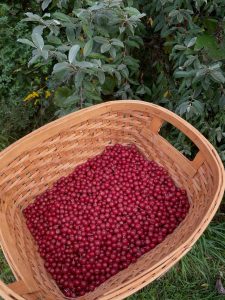Page Created by Connecticut Foraging Club
Upcoming Events | Meet the Instructors | Plant Archive | Mushroom Archive
----------------
Upcoming Events | Meet the Instructors | Plant Archive | Mushroom Archive
----------------
Eastern Prickly Pear (Opuntia humifusa) is a cactus that is native to Connecticut.

The Eastern prickly pear can be found in sunny, dry environments. It prefers sandy, rocky soil and tends to form large colonies. The Eastern prickly pear can survive freezing temperatures due to high levels of glucose in its cells.

The cactus has flat, round pads, or nopales. It produces yellow flowers, sometimes with red centers, in late June-early July. The flowers become green fruits that ripen to red in early Fall.
Young Eastern prickly pear pads can be peeled and cooked like green beans. Flower petals can be enjoyed raw in salads. Fruit can be eaten raw after removing the outer skin with its spiny bristles. The fruit has a tangy melon-like flavor. Seeds can be ground into an edible flour.
Pads and fruit should be gathered with tongs or folded towels due to their sharp spines.
Eastern prickly pear has been used medicinally to reduce inflammation, treat respiratory ailments, and to decrease blood sugar.

The Eastern prickly pear has no toxic look-alikes.
To propagate this native cactus, take a pad in spring-summer and place it in your desired location. Within a few weeks the plant will have put down roots. Be cognizant of where you place the prickly pear as it tends to form large colonies. Despite this ability to propagate, the cacti’s population is decreasing in CT due to habitat loss.
--
Written by Amy Demers, founder of the Connecticut Foraging Club. To learn more about foraging in Connecticut, check out our upcoming classes.






